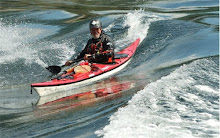Thursday, November 17, 2005
hanging draw
Wednesday, November 16, 2005
Wind Gauge
Here it Long Beach we keep it fairly simple yet incredibly accurate. I
have a rock on a string hanging outside the window. If the rock is
moving, it is windy, if it is wet then it is raining, if it is warm then
it is sunny and if I can't see it then it is foggy. What else do you need?
Monday, November 14, 2005
Short Tows
The following is from scoutXing
| Knots - Mooring Hitch
|
| An underhand loop toggled to the standing part with a bight made in the running end To securely tie off a rope so that it can be quickly untied, especially a small boat to a dock or piling. A secure knot that is easily tied or untied in wet or dry rope; when properly tied a non closing loop is formed, this allows the hitch to move up or down a piling as the water level changes. (1) Take a bight around an object. (2) Form an underhand loop in the running part. (3) Place the eye of the underhand loop over the standing part. (4) Pull a bight of the standing part through the eye of the underhand loop. (5) Pull the underhand loop tight around the bight. (6) Place the running part under the eye of the bight that was pulled through the underhand loop. (7) Pull a bight of the running part through the eye of the standing part bight. (8) Pull on the standing part to tighten the standing part bight around the running part bight.
|
| |
|
|
Tuesday, July 05, 2005
The value of professional instruction
Forward Stroke
In regard to the the cadence and blade placement, consider the following. The blade has the most grip on the water when it is vertical and perpendicular to the boat. In a average stoke this distance is only about 18-24". The idea of spearing the fish, ie reaching forward on the catch places the blade less than vertical initially is far less than efficient but is neccessary when the boat is moving rapidly. This is more of a wind up than a catch. So if the most efficient stroke length is only 24" you can actually get more out of it with good torso rotation and straighter arms because as you rotate with straight arms the blade while still vertical and perpendicular moves diagonally turning the 24" of grip to say 30" or more before the slice. The key is a vertical paddle shaft. Cadence follows as the slice out sets up the following stroke on the other side. Try paddling slowly with nearly straight arms and see if this makes sense.


